Exhibit 99.2
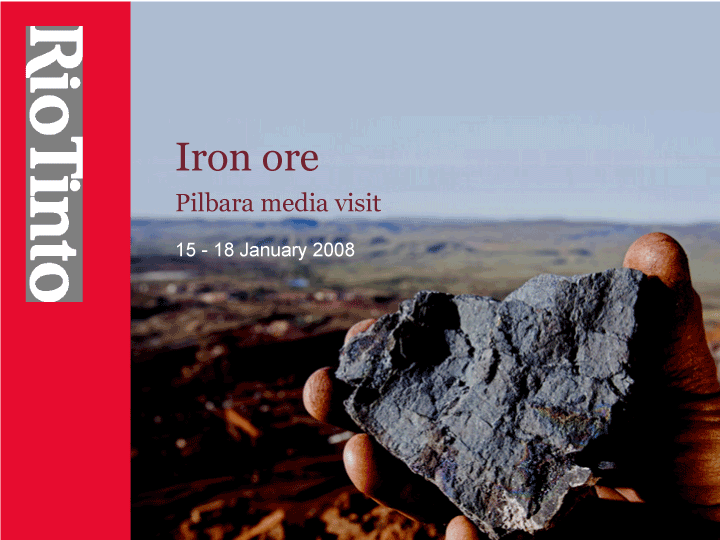
| Exhibit |
| 18 January 2008 |
| Iron ore Pilbara media v,isit |
| 15 – 18 January 2008 |

| Exhibit |
| 18 January 2008 |
| Iron ore Pilbara media v,isit |
| 15 – 18 January 2008 |
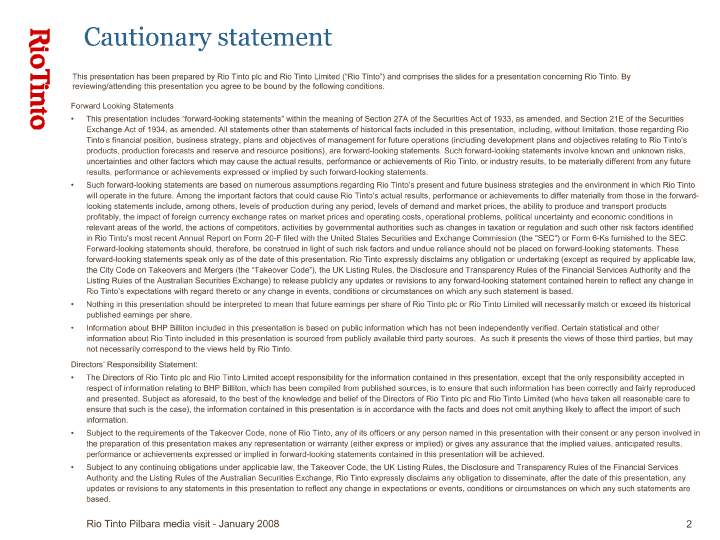
| Cautionary statement |
| This presentation has been prepared by Rio Tinto plc and Rio Tinto Limited (“Rio Tinto”) and comprises the slides for a presentation concerning Rio Tinto. By reviewing/attending this presentation you agree to be bound by the following conditions. |
| Forward Looking Statements |
| · This presentation includes “forward-looking statements” within the meaning of Section 27A of the Securities Act of 1933, as amended, and Section 21E of the Securities Exchange Act of 1934, as amended. All statements other than statements of historical facts included in this presentation, including, without limitation, those regarding Rio Tinto’s financial position, business strategy, plans and objectives of management for future operations (including development plans and objectives relating to Rio Tinto’s products, production forecasts and reserve and resource positions), are forward-looking statements. Such forward-looking statements involve known and unknown risks, uncertainties and other factors which may cause the actual results, performance or achievements of Rio Tinto, or industry results, to be materially different from any future results, performance or achievements expressed or implied by such forward-looking statements. |
| · Such forward-looking statements are based on numerous assumptions regarding Rio Tinto’s present and future business strategies and the environment in which Rio Tinto will operate in the future. Among the important factors that could cause Rio Tinto’s actual results, performance or achievements to differ materially from those in the forward-looking statements include, among others, levels of production during any period, levels of demand and market prices, the ability to produce and transport products profitably, the impact of foreign currency exchange rates on market prices and operating costs, operational problems, political uncertainty and economic conditions in relevant areas of the world, the actions of competitors, activities by governmental authorities such as changes in taxation or regulation and such other risk factors identified in Rio Tinto’s most recent Annual Report on Form 20-F filed with the United States Securities and Exchange Commission (the “SEC”) or Form 6-Ks furnished to the SEC. Forward-looking statements should, therefore, be construed in light of such risk factors and undue reliance should not be placed on forward-looking statements. These forward-looking statements speak only as of the date of this presentation. Rio Tinto expressly disclaims any obligation or undertaking (except as required by applicable law, the City Code on Takeovers and Mergers (the “Takeover Code”), the UK Listing Rules, the Disclosure and Transparency Rules of the Financial Services Authority and the Listing Rules of the Australian Securities Exchange) to release publicly any updates or revisions to any forward-looking statement contained herein to reflect any change in Rio Tinto’s expectations with regard thereto or any change in events, conditions or circumstances on which any such statement is based. |
| · Nothing in this presentation should be interpreted to mean that future earnings per share of Rio Tinto plc or Rio Tinto Limited will necessarily match or exceed its historical published earnings per share. |
| · Information about BHP Billiton included in this presentation is based on public information which has not been independently verified. Certain statistical and other information about Rio Tinto included in this presentation is sourced from publicly available third party sources. As such it presents the views of those third parties, but may not necessarily correspond to the views held by Rio Tinto. |
| Directors’ Responsibility Statement: |
| · The Directors of Rio Tinto plc and Rio Tinto Limited accept responsibility for the information contained in this presentation, except that the only responsibility accepted in respect of information relating to BHP Billiton, which has been compiled from published sources, is to ensure that such information has been correctly and fairly reproduced and presented. Subject as aforesaid, to the best of the knowledge and belief of the Directors of Rio Tinto plc and Rio Tinto Limited (who have taken all reasonable care to ensure that such is the case), the information contained in this presentation is in accordance with the facts and does not omit anything likely to affect the import of such information. |
| · Subject to the requirements of the Takeover Code, none of Rio Tinto, any of its officers or any person named in this presentation with their consent or any person involved in the preparation of this presentation makes any representation or warranty (either express or implied) or gives any assurance that the implied values, anticipated results, performance or achievements expressed or implied in forward-looking statements contained in this presentation will be achieved. |
| · Subject to any continuing obligations under applicable law, the Takeover Code, the UK Listing Rules, the Disclosure and Transparency Rules of the Financial Services Authority and the Listing Rules of the Australian Securities Exchange, Rio Tinto expressly disclaims any obligation to disseminate, after the date of this presentation, any updates or revisions to any statements in this presentation to reflect any change in expectations or events, conditions or circumstances on which any such statements are based. |
| Rio Tinto Pilbara media visit — January 2008 |
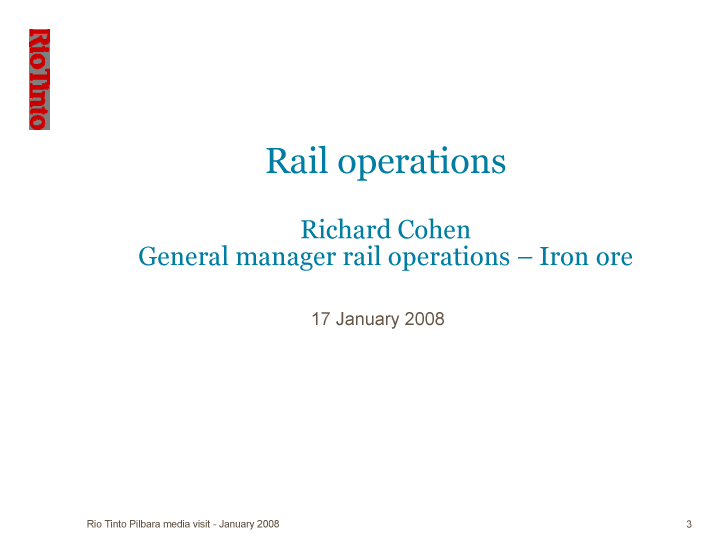
| Rail operations Richard Cohen General manager rail operations – Iron ore |
| 17 January 2008 |
| Rio Tinto Pilbara media visit — January 2008 |
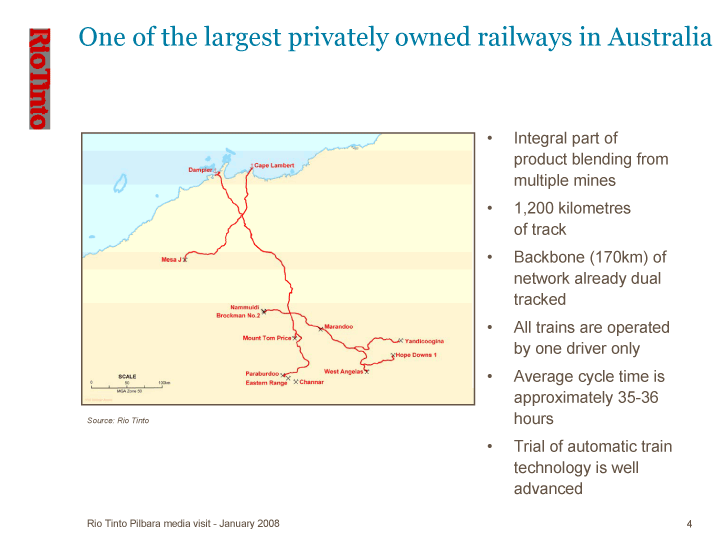
| One of the largest privately owned railways in Australia |
| · Integral part of product blending from multiple mines |
| · 1,200 kilometres of track |
| · Backbone (170km) of network already dual tracked |
| · All trains are operated by one driver only |
| · Average cycle time is approximately 35-36 hours |
| · Trial of automatic train technology is well advanced |
| Rio Tinto Pilbara media visit — January 2008 |
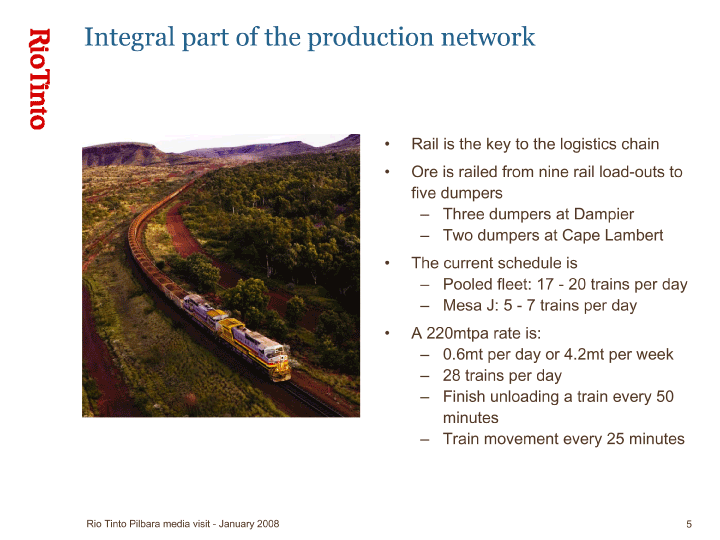
| Integral part of the production network |
| · Rail is the key to the logistics chain |
| · Ore is railed from nine rail load-outs to five dumpers |
| – Three dumpers at Dampier |
| – Two dumpers at Cape Lambert |
| · The current schedule is |
| – Pooled fleet: 17 — 20 trains per day |
| – Mesa J: 5 — 7 trains per day |
| · A 220mtpa rate is: |
| – 0.6mt per day or 4.2mt per week |
| – 28 trains per day |
| – Finish unloading a train every 50 minutes |
| – Train movement every 25 minutes |
| Rio Tinto Pilbara media visit — January 2008 |
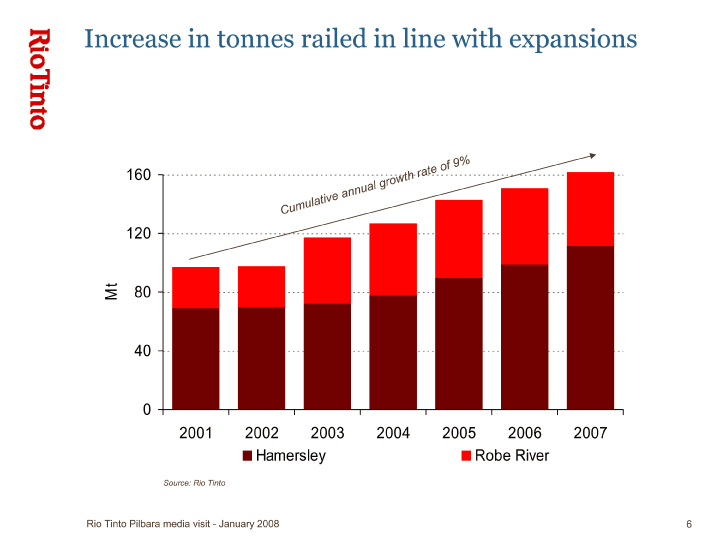
| Increase in tonnes railed in line with expansions |
| Hamersley |
| Robe River |
| Source: Rio Tinto |
| Rio Tinto Pilbara media visit -January 2008 |
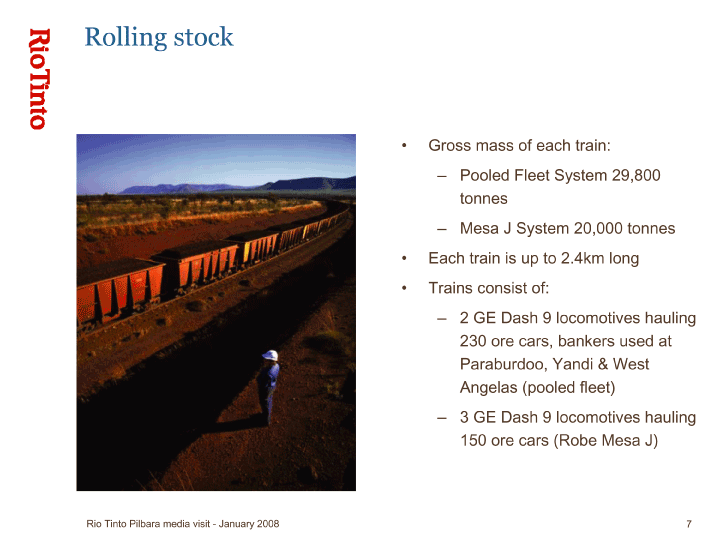
| Rolling stock |
| · Gross mass of each train: |
| –Pooled Fleet System 29,800 tonnes |
| –Mesa J System 20,000 tonnes |
| · Each train is up to 2.4km long |
| · Trains consist of: |
| – 2 GE Dash 9 locomotives hauling 230 ore cars, bankers used at Paraburdoo, Yandi & West Angelas (pooled fleet) |
| – 3 GE Dash 9 locomotives hauling 150 ore cars (Robe Mesa J) |
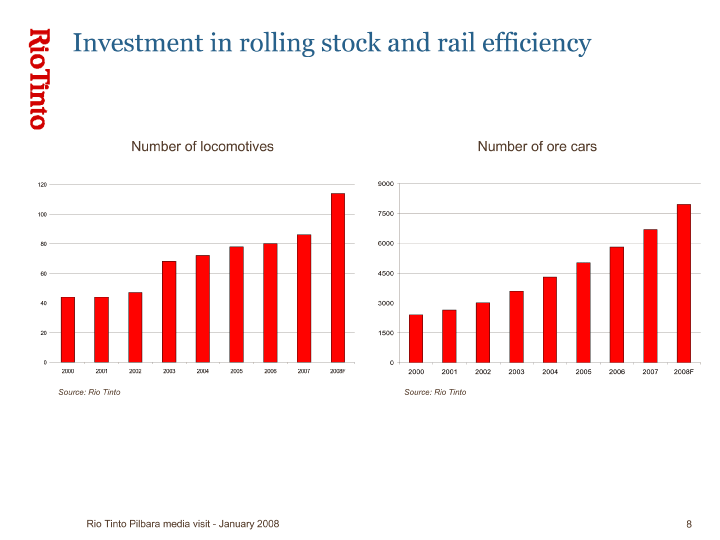
| Investment in rolling stock and rail efficiency |
| Number of ore cars Number of locomotives |
| Source: Rio Tinto |
| Source: Rio Tinto |
| January 2008 Rio Tinto Pilbara media visit - |
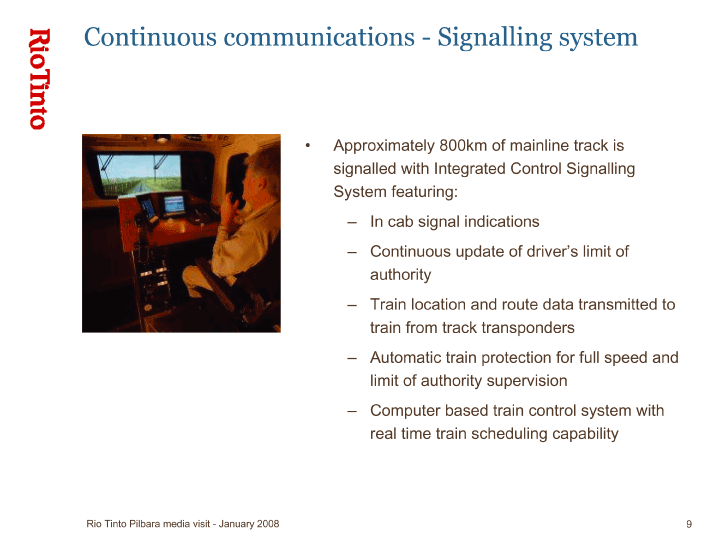
| Continuous communications — Signalling system |
| · Approximately 800km of mainline track is signalled with Integrated Control Signalling System featuring: |
| – In cab signal indications |
| – Continuous update of driver’s limit of authority |
| – Train location and route data transmitted to train from track transponders |
| – Automatic train protection for full speed and limit of authority supervision |
| – Computer based train control system with real time train scheduling capability |
| Rio Tinto Pilbara media visit — January 2008 |
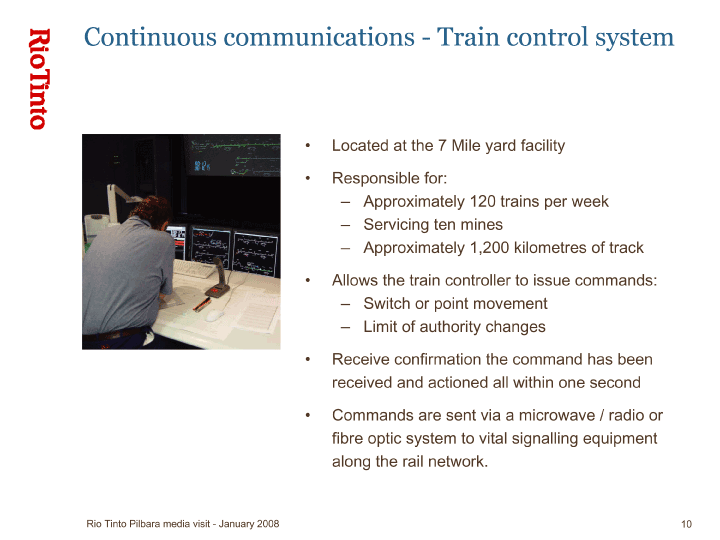
| Continuous communications — Train control system |
| · Located at the 7 Mile yard facility |
| · Responsible for: |
| – Approximately 120 trains per week |
| – Servicing ten mines |
| – Approximately 1,200 kilometres of track |
| · Allows the train controller to issue commands: |
| – Switch or point movement |
| – Limit of authority changes |
| · Receive confirmation the command has been received and actioned all within one second |
| · Commands are sent via a microwave / radio or fibre optic system to vital signalling equipment along the rail network. |
| Rio Tinto Pilbara media visit — January 2008 |

| Construction activity |
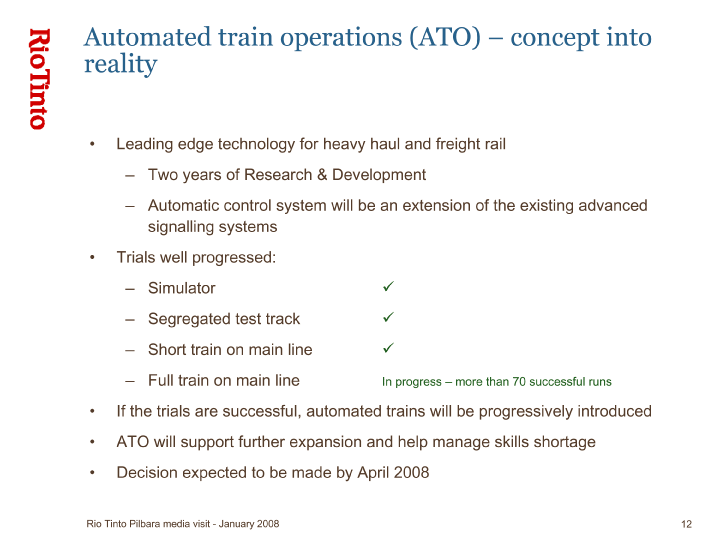
| Automated train operations (ATO) – concept into reality |
| · Leading edge technology for heavy haul and freight rail |
| – Two years of Research & Development |
| – Automatic control system will be an extension of the existing advanced signalling systems |
| · Trials well progressed: |
| – Simulator 9 |
| – Segregated test track 9 |
| – Short train on main line 9 |
| – Full train on main line In progress – more than 70 successful runs |
| · If the trials are successful, automated trains will be progressively introduced |
| · ATO will support further expansion and help manage skills shortage |
| · Decision expected to be made by April 2008 |
| Rio Tinto Pilbara media visit — January 2008 |
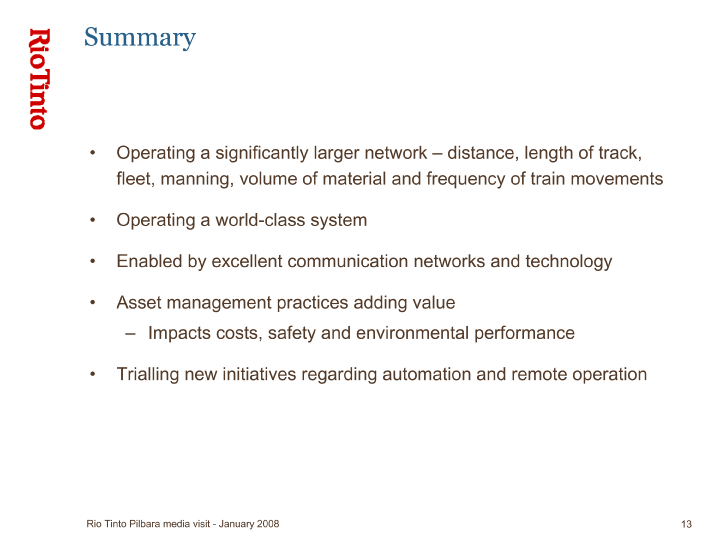
| Summary |
| · Operating a significantly larger network – distance, length of track, fleet, manning, volume of material and frequency of train movements |
| · Operating a world-class system |
| · Enabled by excellent communication networks and technology |
| · Asset management practices adding value |
| –Impacts costs, safety and environmental performance |
| · Trialling new initiatives regarding automation and remote operation |
| Rio Tinto Pilbara media visit — January 2008 |